
Classic or with a twist, croquettes are finger-licking (©José Barea. MD).
A serving of croquettes! Calamari coming right up! There’s a bit of space in the back somewhere… Let’s be honest – is there anything more tempting than losing yourself to the cheery atmosphere of the city’s countless bars? But you won’t feel like a true Madrileño through and through until you’ve enjoyed some good times with friends over a few cañas (beers) and tapas. Here’s a little selection I’ve put together of Madrilenians’ favourite aperitivo (pre-lunch snack).
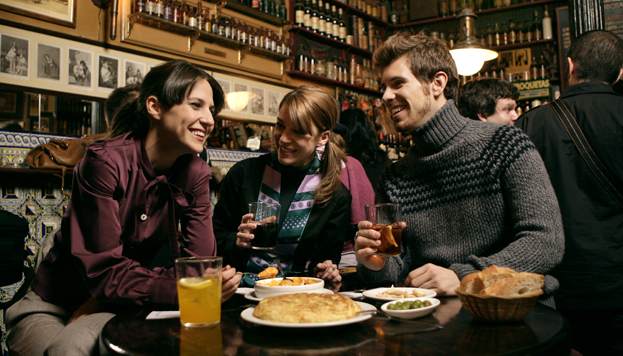
La Ardosa in the Malasaña neighbourhood makes one of the best tortillas (potato omelettes) in Madrid.
1. Pincho de tortilla (a slice of potato omelette) The hora del aperitivo, or the time when light food and drinks are typically enjoyed before lunch, wouldn’t be the same in Madrid if the choices didn’t include a bit of omelette…made with potatoes, of course! A simple snack that’s truly tasty, it seems to have been invented during the Carlist Wars to satisfy soldiers’ appetites at a time when food was scarce. To try it as tradition dictates – moist and with onions and extra virgin olive oil – you simply must head to the bar La Ardosa in the Malasaña neighbourhood, which opened its doors in 1892. Concha Marfil set the gold standard for how to make tortillas here, although you can now sample more modern twists on the traditional classic at some restaurants. At Juana la Loca they make theirs with onion confit.
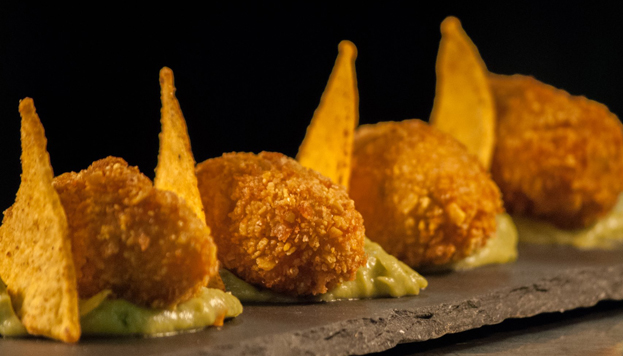
These are the Tex-Mex croquettes served at La Gastrocroquetería de Chema, but there are many more to choose from.
2. Croquetas (croquettes) According to the dictionary definition, a croquette is a piece of dough with various minced ingredients held together with béchamel sauce, battered with egg and breadcrumbs and fried in plenty of oil. But words are sometimes unnecessary! It’s best just to try them, as there are versions to suit all palates. The most famous are those made with ham, but you can also get them with cod, porcini, chicken… the list goes on. If you want a bit of variety, pop in to La Gastrocroquetería de Chema. Pure temptation! Here you’ll find all kinds, including: Galician-style octopus croquettes; ones made from curried chicken, roasted corn kernel and apple; liquid cheese croquettes served over tomato confit and black olives; and those prepared using gratinéed cuttlefish in its ink. Need more options? Try the ham or prawn ones at Taberna Viavélez, or other creative options at La Croquetta (made with blood sausage, potato omelette and even stout). At La Antoñita they have transformed another traditional Madrid aperitivo into a croquette: tigres (fried battered muscles).
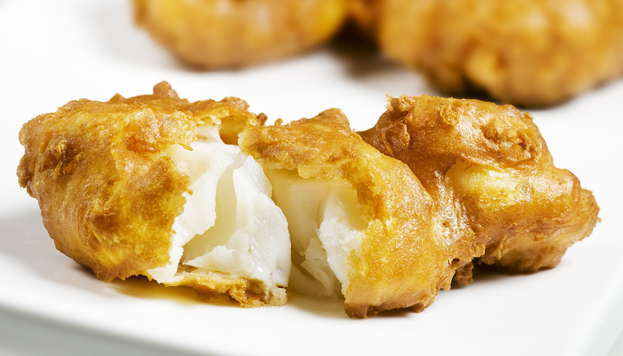
Just waiting for you to sink your teeth into it: that’s how tasty the battered cod is at Casa Labra (©José Barea. MD).
3. Soldaditos de Pavía (fried battered cod) The honours for making this aperitivo one of the city’s most traditional bites go to the legendary Casa Labra on Calle Tetuán, next to Puerta del Sol. When the hussars under General Pavía’s command dissolved the Spanish parliament on 3 January 1874, putting an end to the First Republic, Madrid’s people likened the reddish tone of the soldiers’ military coats to that of the battered piece of cod wrapped in red pepper served in the tavern. Today it’s no longer made with that particular garnish, but it is very, very tasty. Still haven’t tried it? Another place where the battered cod is out of this world is Casa Revuelta, a Madrid classic..

Up to 2,000 kilos of potatoes are fried each week at the bar Docamar. Its patatas bravas are to die for.
4. Patatas bravas (fried potatoes with spicy tomato sauce) Could anything be more traditional than going for tapas with friends and ordering some patatas bravas? Some call them patatas a la brava, but what’s in a name? They are, as you know, potatoes cut into chunks, fried in oil and served with a spicy sauce. As for the sauce, everyone has their own special recipe. If you’re strolling around downtown Madrid you must stop off at any of the Las Bravas bars. I personally like the one on Álvarez Gato, as it still features the convex and concave mirrors in which Max Estrella, the main character in the play Ramón del Valle-Inclán’s Bohemian Lights, perceived a distorted reality. Don’t ask what the secret ingredient in the sauce is. And don’t do that at my favourite haunt for enjoying this heaven-sent food, either: Docamar (Calle Alcalá, 237) in the Ciudad Lineal neighbourhood near Las Ventas Bullring. Here’s a fun fact for the curious: every week they fry over 2,000 kilos of potatoes! At Vi Cool, chef Sergi Arola imbues this classic dish with his particular brand of sophistication. His patatas bravas are glazed potato cylinders filled with a spicy tomato sauce and topped with a dab of alioli (garlic mayonnaise).

Is there anyone who hasn’t tried a bocata de calamares on Plaza Mayor? It’s a must.
5. Bocata de calamares (Sergi Arola is actually also behind one of the most surprising updates to the traditional calamari sandwich. You can try it at SOT, his newly opened vermouth bar, but note that they refer to it as calamares haciéndole un bocata a un trozo de pan (calamari making a sandwich out of a piece of bread). It’s not easy to determine the origin of this culinary tradition, bearing in mind that Madrid is not on the sea, but eating battered fish is clearly a Sephardic custom. In Plaza Mayor and the surrounding area there are countless bars, such as Casa Rúa or Valle del Tiétar, where you can try a more traditional style bocadillo de calamares.

There’s no bar in Madrid that doesn’t serve boquerones en vinagre (anchovies in vinegar). The ones above come with olives.
6. Boquerones en vinagre (anchovies in vinegar) Imagine this scenario: it’s a hot day in Madrid (that marvellous autumn sun, perhaps). We sit down at an outdoor café and order a beer or soft drink. What more is needed to make this wonderfully relaxing moment complete? I don’t need to think twice doubt about it: some chips and some anchovies in vinegar, that is, anchovy fillets that have previously been marinated in oil and plenty of garlic and parsley. You’ll find them everywhere, as practically all of the bars in Madrid serve them. Some examples are La Dolores, in the heart of the Literary Quarter, and La Taberna de Ángel Sierra in Calle Gravina next to Plaza de Chueca..
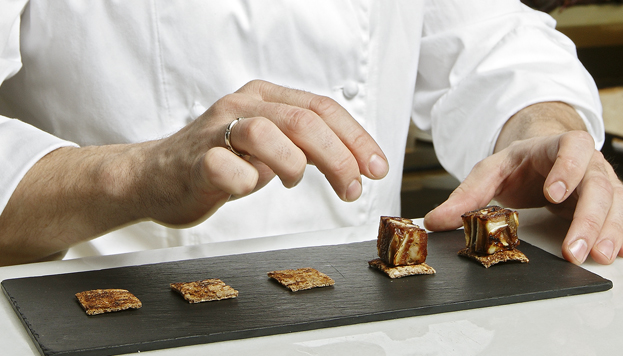
These sophisticated pig’s ear tapas are made at Estado Puro, but the traditional version is very tasty too.
7. Oreja a la plancha (grilled pig’s ear) You must head down to the Carabanchel neighbourhood to try one of Madrid’s most traditional and authentic tapas: minutejos, a sort of sandwich stuffed with sliced pig’s ear drizzled with spicy sauce. This classic is, of course, the house speciality at La Casa de los Minutejos (Antonio Leiva, 19), although there are other options if you want to sample a nice serving of pig’s ear. In the heart of the city is La Oreja de Jaime, a little tavern on Calle de la Cruz where they really know how to make it, doing the tavern’s name (La Oreja, or “the Ear”) proud. You definitely need to eat it standing up at the bar, the way it’s best enjoyed. The photo I’ve posted for you is of the succulent tapas made for us one time by Paco Roncero, a chef who takes great pleasure in working in the kitchen at Estado Puro.
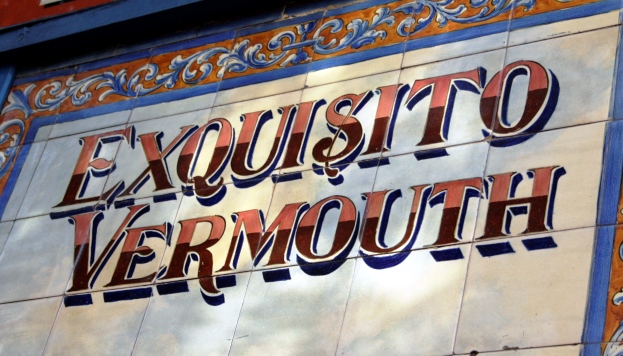
Though it’s traditional to order a beer in Madrid, many prefer a glass of vermouth to accompany their aperitivo.
8. ¿Caña o vermú? (Beer or vermouth?) Finally, I leave you with some suggestions as to what to drink, since there are many ways to enjoy aperitivos in Madrid. That said, you must always wash them down with a well-pulled beer complete with two fingers of head, or with a vermouth on tap. Many of the establishments I recommend above also serve the best beers in the city, but to broaden the culinary spectrum a bit I’ll highlight two places that you absolutely can’t miss: Cervecería Santa Bárbara, with a tradition dating back to 1815, and El Cangrejero in the Conde Duque neighbourhood, where pouring beer is an art form. For those who prefer vermouth, I suggest you reread the wonderful post written a while ago for Bloggin’ Madrid by my colleague Ignacio Vleming. In it you’ll find places that serve solera-aged vermouth, like Bodegas Rosell, a stone’s throw from Atocha station, or Bodegas Ricla next to Plaza Mayor. There’s just one thing left for me to say: Enjoy!